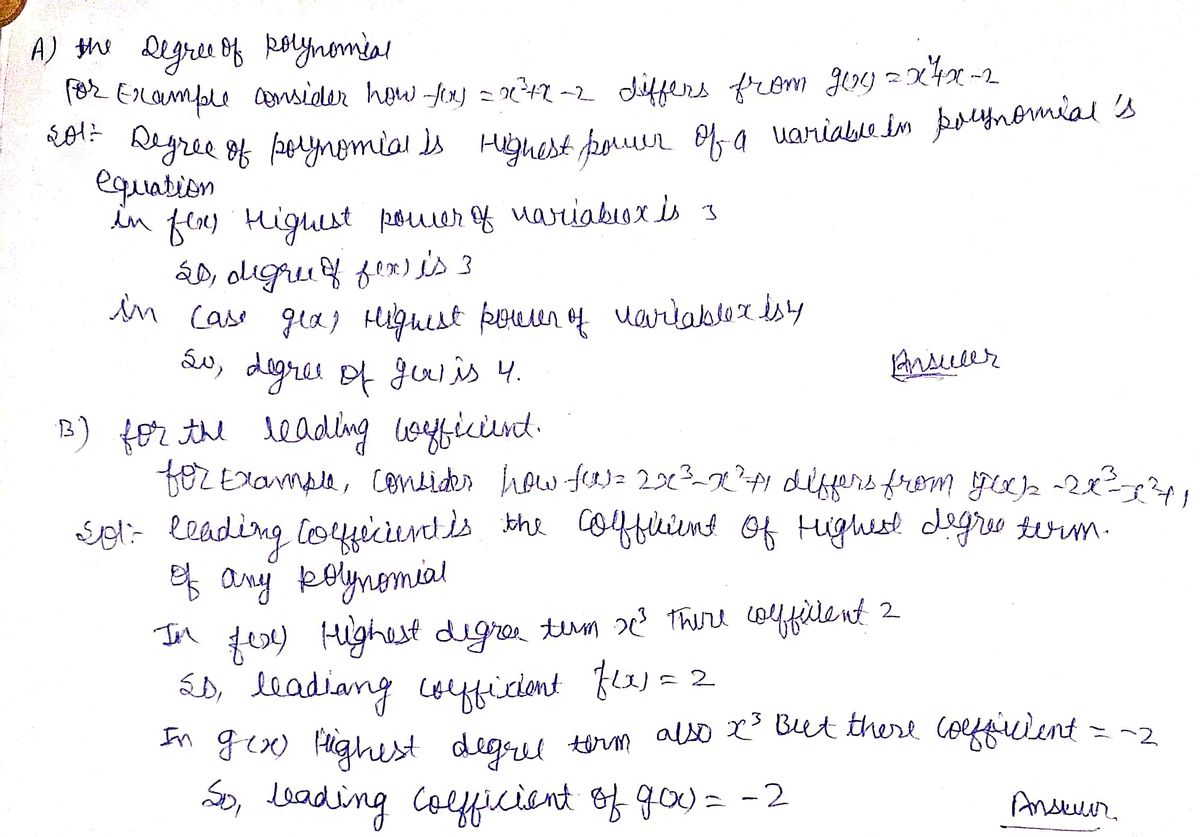Brainstorm Directions: Explain how each of the following affects the appearance of a polynomial graph. Pairs of contrasting examples are given to help your thinking, but be sure to give a generalized response not just discuss the example. A. the degree of the polynomial For example, consider how f(x) = x +x-2 differs from g(x) = x + x-2. B. the leading coefficient For example, consider how f(x) = 2x -x+1 differs from g(x)=-2x-x+1. C. factors and their multiplicity For example, consider how f(x) = (x- 1)(2x - 5) differs from g(x) = (x – 1)(2x – 5).
Brainstorm Directions: Explain how each of the following affects the appearance of a polynomial graph. Pairs of contrasting examples are given to help your thinking, but be sure to give a generalized response not just discuss the example. A. the degree of the polynomial For example, consider how f(x) = x +x-2 differs from g(x) = x + x-2. B. the leading coefficient For example, consider how f(x) = 2x -x+1 differs from g(x)=-2x-x+1. C. factors and their multiplicity For example, consider how f(x) = (x- 1)(2x - 5) differs from g(x) = (x – 1)(2x – 5).
Calculus: Early Transcendentals
8th Edition
ISBN:9781285741550
Author:James Stewart
Publisher:James Stewart
Chapter1: Functions And Models
Section: Chapter Questions
Problem 1RCC: (a) What is a function? What are its domain and range? (b) What is the graph of a function? (c) How...
Related questions
Question

Transcribed Image Text:**Brainstorm**
**Directions:** Explain how each of the following affects the appearance of a polynomial graph. Pairs of contrasting examples are given to help your thinking, but be sure to give a generalized response not just discuss the example.
**A. The degree of the polynomial**
For example, consider how \( f(x) = x^3 + x - 2 \) differs from \( g(x) = x^4 + x - 2 \).
**B. The leading coefficient**
For example, consider how \( f(x) = 2x^3 - x^2 + 1 \) differs from \( g(x) = -2x^3 - x^2 + 1 \).
**C. Factors and their multiplicity**
For example, consider how \( f(x) = (x - 1)(2x - 5)^2 \) differs from \( g(x) = (x - 1)(2x - 5)^3 \).
Expert Solution
Step 1

Step by step
Solved in 2 steps with 2 images

Recommended textbooks for you

Calculus: Early Transcendentals
Calculus
ISBN:
9781285741550
Author:
James Stewart
Publisher:
Cengage Learning

Thomas' Calculus (14th Edition)
Calculus
ISBN:
9780134438986
Author:
Joel R. Hass, Christopher E. Heil, Maurice D. Weir
Publisher:
PEARSON

Calculus: Early Transcendentals (3rd Edition)
Calculus
ISBN:
9780134763644
Author:
William L. Briggs, Lyle Cochran, Bernard Gillett, Eric Schulz
Publisher:
PEARSON

Calculus: Early Transcendentals
Calculus
ISBN:
9781285741550
Author:
James Stewart
Publisher:
Cengage Learning

Thomas' Calculus (14th Edition)
Calculus
ISBN:
9780134438986
Author:
Joel R. Hass, Christopher E. Heil, Maurice D. Weir
Publisher:
PEARSON

Calculus: Early Transcendentals (3rd Edition)
Calculus
ISBN:
9780134763644
Author:
William L. Briggs, Lyle Cochran, Bernard Gillett, Eric Schulz
Publisher:
PEARSON

Calculus: Early Transcendentals
Calculus
ISBN:
9781319050740
Author:
Jon Rogawski, Colin Adams, Robert Franzosa
Publisher:
W. H. Freeman


Calculus: Early Transcendental Functions
Calculus
ISBN:
9781337552516
Author:
Ron Larson, Bruce H. Edwards
Publisher:
Cengage Learning